February 2025
The global cell surface marker detection market size is calculated at USD 6.16 billion in 2025 and is forecasted to reach around USD 12.81 billion by 2034, accelerating at a CAGR of 8.47% from 2025 to 2034. The North America market size surpassed USD 2.27 billion in 2024 and is expanding at a CAGR of 8.62% during the forecast period. The market sizing and forecasts are revenue-based (USD Million/Billion), with 2024 as the base year
The global cell surface marker detection market size was estimated at USD 5.68 billion in 2024 and is predicted to increase from USD 6.16 billion in 2025 to approximately USD 12.81 billion by 2034, expanding at a CAGR of 8.47% from 2025 to 2034. The global market growth is attributed to the increasing demand for precision medicine.
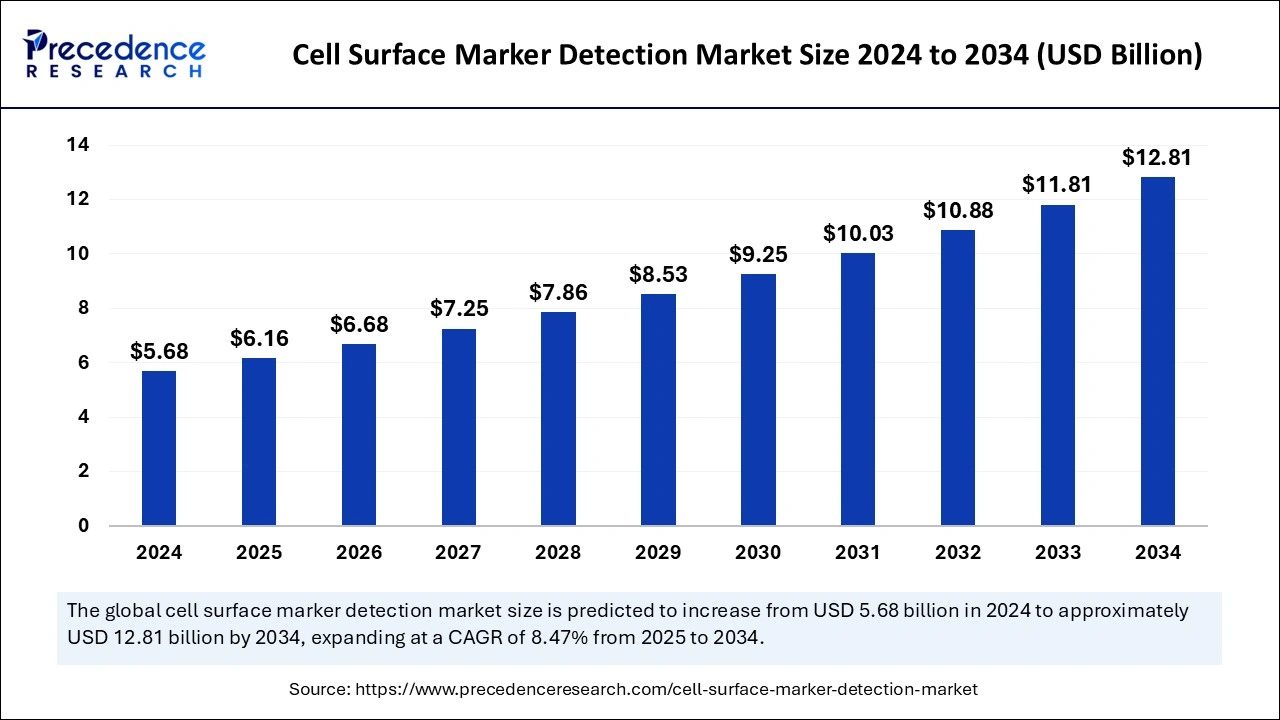
Artificial intelligence is changing various industries, and the chemical industry is no exception. The cell surface marker detection market is transforming rapidly with the integration of AI. AI can enhance production levels in the chemical setting, including quality control, process improvement, failure prevention or prediction, and safety monitoring.
Advanced AI technologies can control the variables of complicated reactions and ensure consistent quality, maximizing yield and enhancing safety by anticipating complex conditions. They can improve the cell surface process, reducing the trial- and error aspect significantly. By design, while meeting consumers’ safety concerns and needs, materials improved through AI are more sustainable and durable. AI in the chemical industry points to a future where precision, efficiency, and innovation are at the forefront.
The U.S. cell surface marker detection market size was exhibited at USD 2.00 billion in 2024 and is projected to be worth around USD 4.59 billion by 2034, growing at a CAGR of 8.66% from 2025 to 2034.
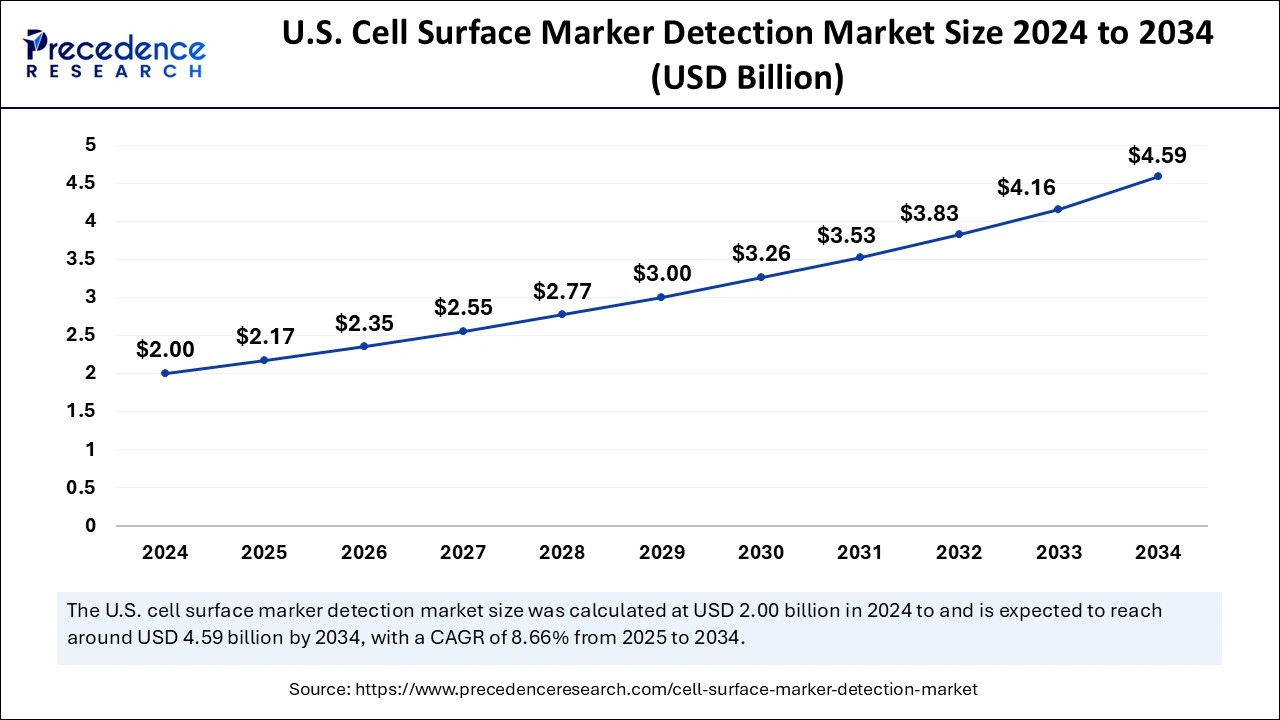
North America dominated the cell surface marker detection market in 2024. The market growth in the region is attributed to the increasing high adoption rate of innovative diagnostic technologies and rising advanced healthcare infrastructure. The U.S. and Canada are the major countries that dominate the market. The growing emphasis on precision medicine and the increasing prevalence of chronic diseases are expected to drive the growth of the cell surface marker detection market in the U.S. In addition, substantial funding for healthcare research and increasing supportive government policies are expected to drive market growth in the U.S.
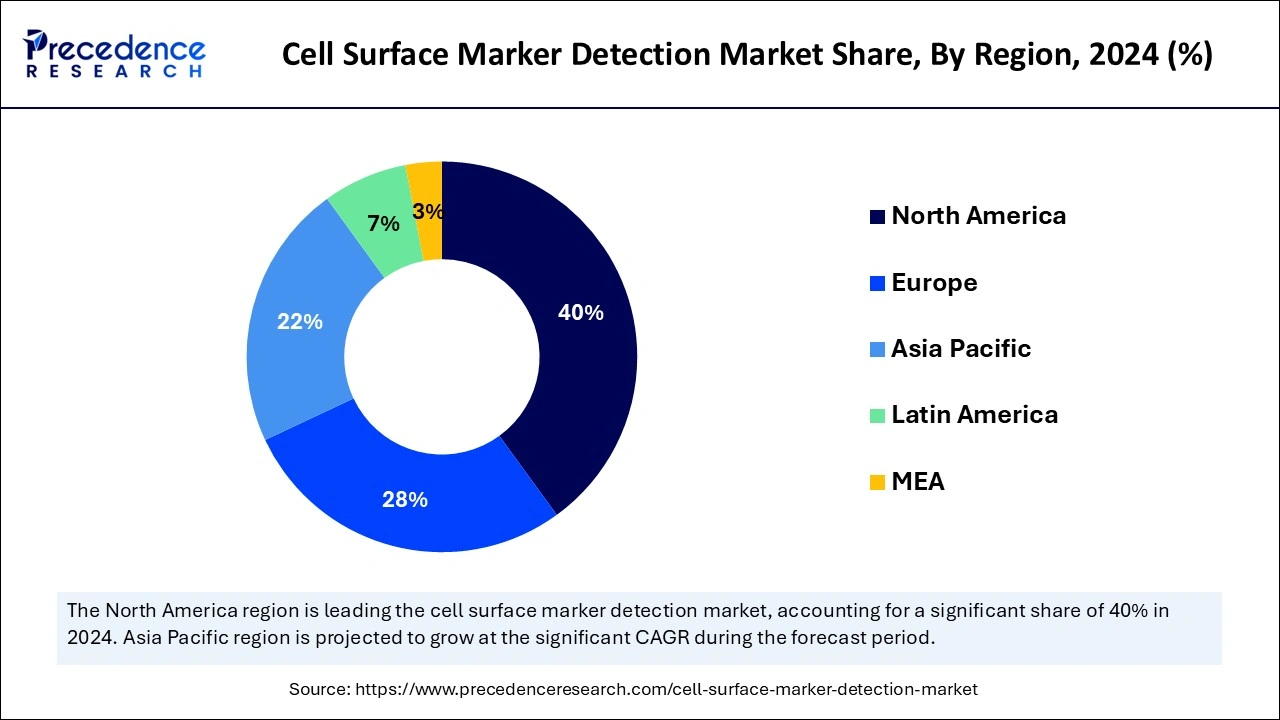
Asia Pacific is expected to grow at the fastest rate in the market during the forecast period. The market growth in the region is attributed to the growing investment in research and development and expanding healthcare infrastructure. In addition, the rising demand for advanced diagnostic tools and the increasing prevalence of chronic diseases are further anticipated to drive the growth of the cell surface marker detection market. China, India, Japan, and South Korea are the fastest-growing countries.
Cell surface markers detection market can be used to differentiate between different types of cells. Cell surface markers such as carbohydrates and proteins linked to the cellular membrane must function to play an important role in intercellular signaling. By analyzing the composition of the cell surface indicators present on a particular cell, one can recognize a cell and distinguish it from the neighborhood of cells. In addition, the increasing amount of research projects on molecular cell biology and biology techniques, the growing prevalence of chronic diseases, and the increasing need for early diagnosis are expected to drive the growth of the cell surface marker detection market.
| Report Coverage | Details |
| Market Size by 2034 | USD 12.81 Billion |
| Market Size in 2025 | USD 6.16 Billion |
| Market Size in 2024 | USD 5.68 Billion |
| Market Growth Rate from 2025 to 2034 | CAGR of 8.47% |
| Dominating Region | North America |
| Fastest Growing Region | Asia Pacific |
| Base Year | 2024 |
| Forecast Period | 2025 to 2034 |
| Segments Covered | Product, Application and Regions. |
| Regions Covered | North America, Europe, Asia-Pacific, Latin America, and Middle East & Africa |
The increasing demand for precision medicine
Precision medicine is finding adoption in cancer and inherited diseases and also in a range of subspecialties for both diagnosis and treatment, using next-generation sequencing. Precision medicine enhances the overall health of populations through the application of pharmacogenomics and brings down the total cost of care, which uses the data of patients to create effective and safe plans for patient medication.
In addition, precision medicine is an innovative method of modifying prevention approaches and disease treatment. It allows doctors and researchers to predict more accurately the proper treatment for a patient with data on their environment, lifestyle, genetic makeup, and makeup. Furthermore, precision medicine approaches are reducing the cost of healthcare and enhancing the outcomes of treatment.
High cost of instruments
The high cost of instruments is the major restraining factor for the cell surface marker detection market. Due to the unclear cost-benefit relationship, pharmaceutical companies need to invest significantly in instruments, such as hematology analyzers and flow cytometers, to research cell surface markers, which may create major challenges in the market demand and further expected to restrain the growth of the market.
Development of novel products
Various governments and market players across the globe are focusing on developing innovative or novel products in the cell surface marker detection market due to the increase in the use of cell surface marker detection in technological advances and diagnostics. In addition, the rise in global disease burden has increased the demand for cell surface markers detection technologies for research diagnostics applications. These developments are likely to increase the demand for such technologies.
The reagents and kits segment dominated the global cell surface marker detection market in 2024. The segment growth in the market is attributed to the growing adoption of in vitro diagnostics, the rising advancements in diagnostic technologies, and the increasing consumables in various detection techniques, such as Western blotting primarily, immunohistochemistry, and flow cytometry. These kits and reagents' non-reusable nature necessitate continuous reorders, further accelerating the market demand. In addition, the increasing prevalence of chronic diseases and the increasing focus on precision medicine have enhanced the need for reliable and accurate diagnostic tools, further driving the demand for these products.
The hematology analyzers segment is expected to grow at the fastest rate during the forecast period. The segment growth in the market is attributed to rising technological advancements in these analyzers, such as improved accuracy and enhanced automation, making them more reliable and efficient for clinical use. In addition, the increasing prevalence of chronic diseases and blood-related diseases necessitates advanced diagnostic tools. Furthermore, the increasing adoption of precision medicine is significantly based on accurate blood analysis.
The disease diagnosis and identification segment held the largest cell surface marker detection market share in 2024. The segment growth in the market is attributed to the increasing prevalence of chronic diseases such as autoimmune diseases and cancer. These diseases necessitate early and precise diagnosis. In addition, the rising advancements in diagnostic technologies, such as automation and high-throughput tools, have improved the reliability and efficiency of disease detection. Furthermore, the ability of cell surface markers to efficiently isolate and identify specific cell types makes them indispensable in clinical settings and revolutionizes diagnostic practices. In addition, the rising emphasis on precision medicine, which is significantly based on accurate disease diagnosis, is further expected to accelerate the demand for cell surface maker detection.
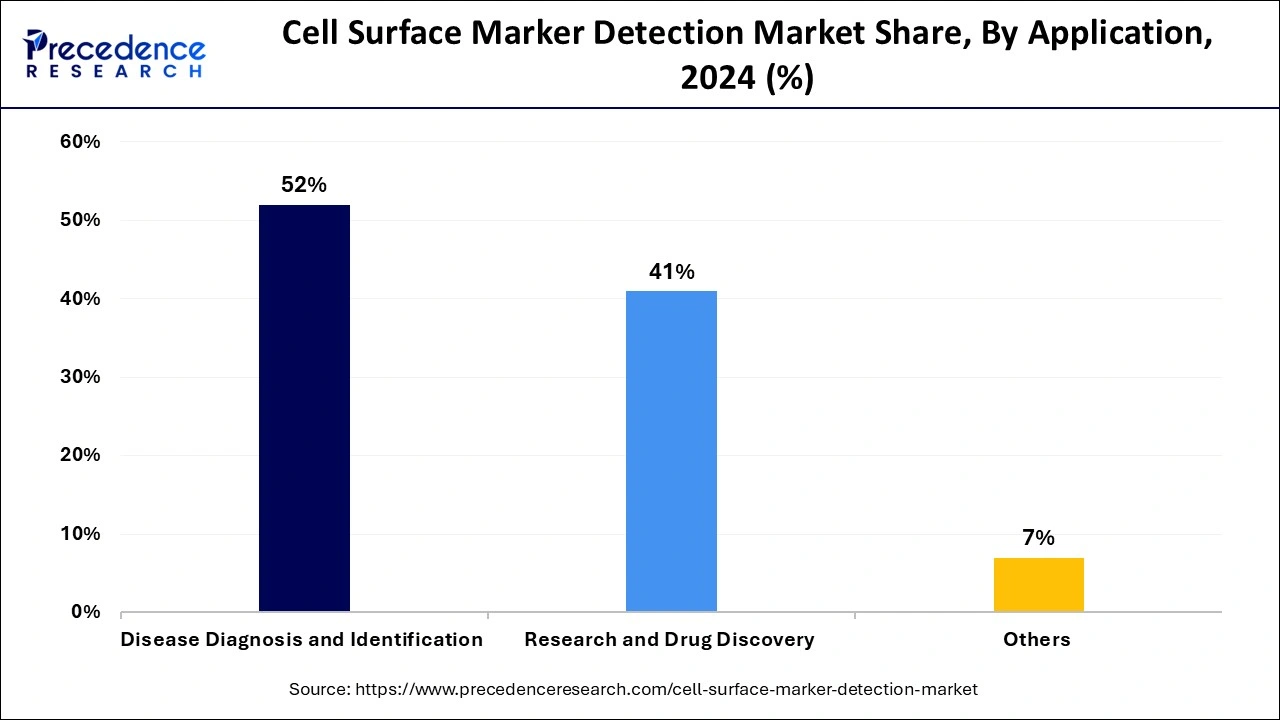
The research and drug discovery segment is expected to grow rapidly during the forecast period. The segment growth in the market is driven by the rising technological advancements in cell surface marker detection, such as automation and high-throughput screening. In addition, the growing emphasis on precision medicine, which is heavily based on identifying specific cell markers to improve targeted therapies, increasing collaborations between research institutions and pharmaceutical companies, and increasing the prevalence of chronic diseases are further expanding the application.
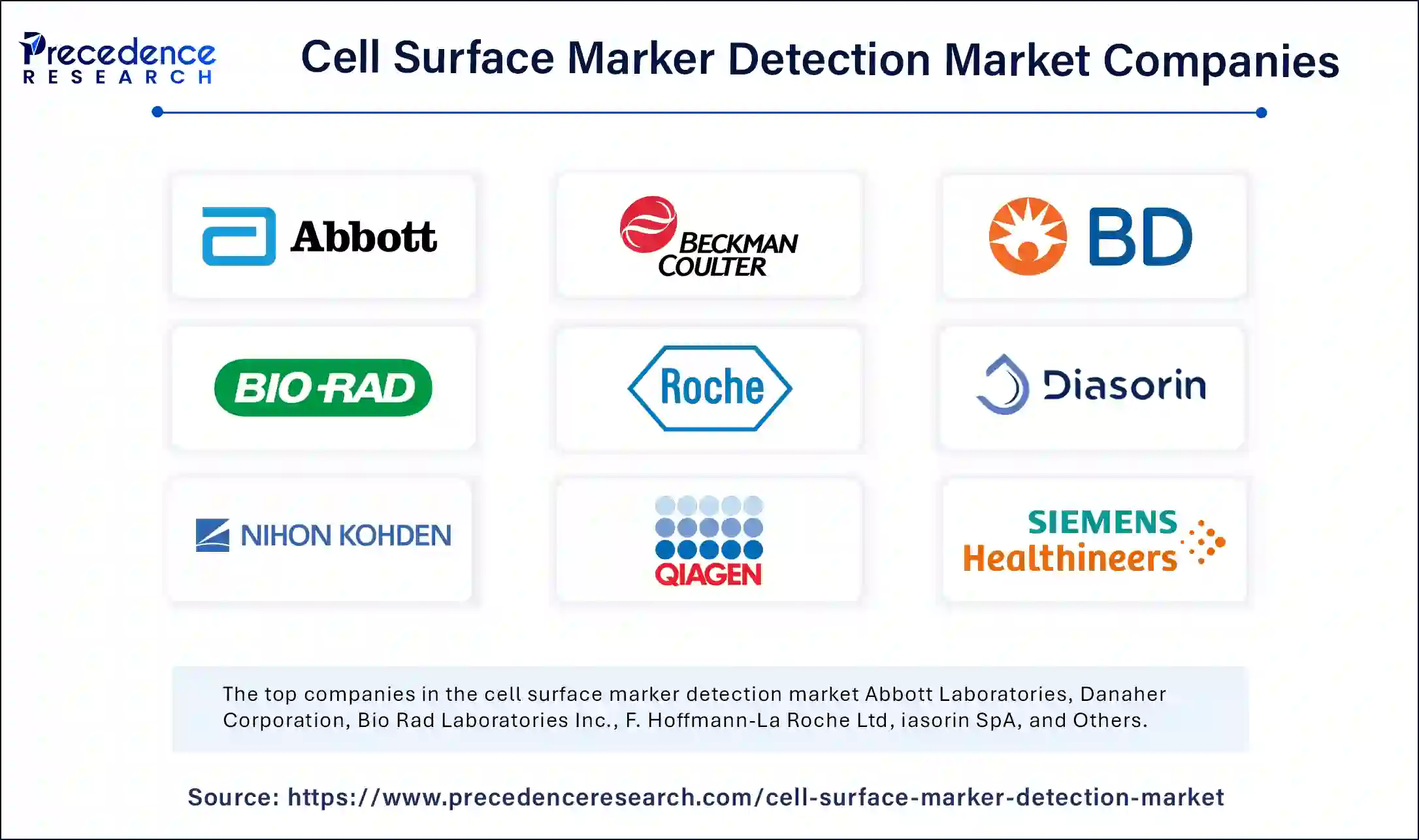
By Product
By Application
By Geography
For inquiries regarding discounts, bulk purchases, or customization requests, please contact us at sales@precedenceresearch.com
No cookie-cutter, only authentic analysis – take the 1st step to become a Precedence Research client
February 2025
January 2025
January 2025
January 2025